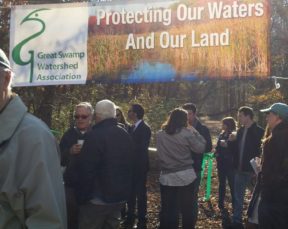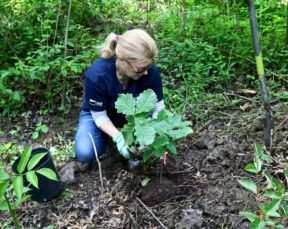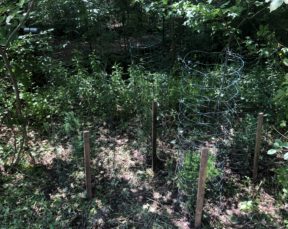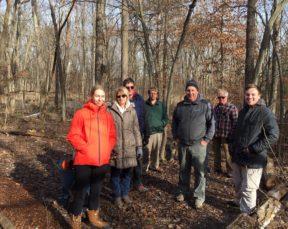A story of Unfolding Stewardship over a decade in the making!
By Hazel England
Looking back recently over more than twelve years of stewardship carried out at Great Swamp Watershed Association’s Conservation Management Area (CMA), I realized that I have written numerous newsletter articles detailing ‘exciting new developments’, and ‘happy announcements of work finished’ at GSWA’s flagship 53 acre property in Harding, NJ! From the excitement of finally completing the fencing of 23 acres of forested wetlands in the fall of 2005- with a majority of volunteer hours, to creating the 300 plus feet of elevated marsh boardwalk trail in 2008; restoring and enhancing vernal pools for wildlife; to adding interpretive signs and kiosks at the trailheads, there have been many chances to announce exciting completions of new projects in more than a decade of management and stewardship at the property.
In retrospect, many of these newsletter articles could have been summarized by the much briefer and pithier statement – ‘build it and they will come’.
Build fence around 30 acres of upland and wetland forest habitat to exclude voracious deer, and “they”, the native forest understory shrubs and tree seedlings of tulip poplar, oaks, hickories and blueberries, protected from deer browse by an eight foot high fence, are able to gradually regenerate the complex understory that this type of forest should contain. A walk at the CMA no longer allows views through the understory of several hundred feet, but showcases the dense and growing understory of a regenerating, primarily native forest. It is so unusual to have such a large piece of deer protected forest that botanists from Raritan Valley Community College are using the site for plot sampling of plant biodiversity as a comparison site in a Piedmont study of native forests and the impacts of deer, and ecology students from Drew University in an annual survey of small mammal populations in the region.
Build simple wooden bench seating areas with untold hours of volunteer labor, and outdoor teaching areas are created allowing for expanded public programs on subjects ranging from native and invasive plant identification, New Jersey forest ecology, night noise hikes to listen for owls, and wetland hydrology classes to occur at the property. It is much easier to teach effectively, when students are gathered around and able to see, rather than strung out along a narrow trail. This is evidenced by the long and growing list of schools, community groups and colleges that have visited the property for GSWA led programming over the last year. Hundreds of students from Rutgers, William Paterson and Fairleigh Dickenson University, Bloomfield and Passaic County Colleges and area high schools and elementary schools, enjoyed a variety of programming at the site over the year. Highlights included 50 young second and third grade students from the Cornerstone program in Morristown, who visited twice over the summer for healthy, energizing nature hikes around the property, and learned hands on about the creatures that live in the CMA streams and planted native perennials along their banks. Other notable visitors were six (count em’) AP Environmental Science classes of Chatham High Schoolers who each spent a full day measuring tree biodiversity and collecting chemical and biological data as they experienced firsthand terrestrial ecology and aquatic field skills, while gathering data for further study back in their classroom. The list of those who have visited is diverse and growing, but we always welcome visitors- contact Hazel hazele@greatswamp.org if you are interested in a tour or program at the CMA (See insert for a full list of those who visited this year).
Build thousands of feet of boardwalk, miles of mulched trail and keep adding more mileage with innovative trail expansions and hikers, dog walkers and students of all ages will come! They utilize our well marked loop trails for engaging ecological lessons, casual Sunday hikes or vigorous calorie burning exercising sessions. We are able to conduct more of our public programming at the CMA, but are often pleasantly surprised to drive up to the site and find a group of cross country runners who have decided to run there, or a couple walking their dogs (on leash of course) enjoying the ability to take their pup for a walk while they enjoy the scenery and exercise at the same time.
Build back the diversity of native plants that should be present with back breaking volunteer led re-plantings of thousands of tiny, fragile seedlings and shrubs, and remove the much larger, seemingly invincible invasive ones that should not, and the complex assemblage of birds, insects and small mammals able to live and breed at the CMA forest grows ever larger and more varied. Enhancing vernal pools at the site over the last three years to deepen them and plug outflows with fallen tree material and berms has kept water present in these spring fed shallow pools for a critical few days longer in the spring, allowing wood frogs, spring peepers and chorus frogs to effectively complete their breeding cycle before the pools dry out. Our annual vernal pool explorations at the site held in late march and April often yield sights of vocalizing spring peepers, breeding wood frogs, and multiple egg masses of these tiny amphibians who call the CMA ponds home to entranced participants in our nighttime vernal pool adventures.
Build a network of helpers. The backbone of our network is our core of seemingly tireless volunteers who enable us to lead larger corporate and community groups and work alone and in small groups in the hot, wet and cold of all twelve months conditions- (you know who you are, but we couldn’t do what we do without you, and I thank you for your continued work at the property). We’ve build a network of ecological experts we can rely on for input and advice to enable our stewardship decisions to be built on best practices available, and to utilize new and innovative solutions to managing a property with volunteers. Our corporate partners who, clad in brightly sloganed T shirts like a group of colorful ants, swarm the property for a day to perform the most energetic of stewardship tasks, which could be anything from barrowing yards of mulch to carrying lumber long distances to build new and repair old boardwalks. Partners this year have included returning team members from Goldman Sachs Community TeamWorks, New Jersey American Water Company employees, BASF Science Academy High school students from throughout North America, Northern New Jersey Geocachers, and Madison and Pingry high schoolers gaining hands on field experience while they benefit from community service hours.
As you can see the ‘build it’ covers many aspects of the value of the CMA, and the ‘they’ is manifold, but the overall result is a developing gem of ecological management, expanding biodiversity, and a great example of leveraging the work of volunteers into concrete, physical improvements at the property. WE hope you will ‘come’ and see for yourself the strides we have made there this year!





